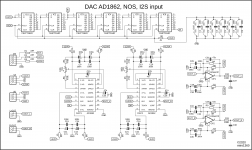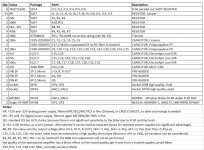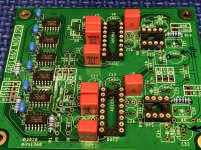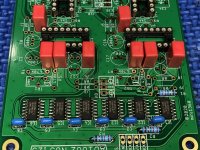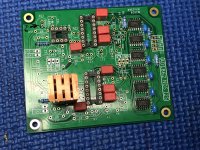adding a filter (5nf to ground) before the OPA IV had a noticeable benefit, more liquid, less haze, but did not really change the overall flat/grey character of the op amp IV.
Maybe it is not fair to compare a single cap to proper reconstruction filter but I cant see it transforming the sound (pun intended) like the trafo. Abraxalito, you have some actual experience with that, so I would like to hear what u think.
I've not so far built a proper reconstruction filter for NOS (by which I mean -96dB @24.1kHz), I think it would need maybe 5 or 6 inductors and be super-sensitive to their tolerance. I have found that many opamps as I/V benefit from having a LP (at least 3rd order) filter in front of them, but the amount of improvement is variable. AD811 had the least benefit, on AD8017 the change was fairly dramatic from flat/uninvolving/washed out to 3D/holographic. I've not tried out yet removing the filter before the AD829 which is I/V on my latest DAC - changing from 3rd order to 7th order makes a difference in dynamics - 7th order giving more 'punch' and a lower noise floor.
Could be interesting send it to Amirm to check the overall performance 🙂
Audio Science Review (ASR) Forum
Audio Science Review (ASR) Forum
The sound character does not change much when playing oversampled files, it may be the OPA1612 does not benefit much from filtering but also that its just not a very good sounding choice for IV.
With how good the trafo sounds it's possible that the Ad1862 is a particularly good candidate for passive I/V, the PCM56 and AD1865 are known to accommodate passive IV well since they dont have any internal protection diodes on the output.
The amount of distortion actually generated with passive I/V seems to depend on the DAC, I believe the PCM1704 and some of old PCMxxxx DS DAC were the worst for this but for the TDA1541 this post reports only marginal increase in THD below 320mV, and the TDA1541 even has protection diodes so this sudden spike may only be a result of that.
He measure 0.002% at 320mV... spec is 0.0018%! 😕 thats practically nothing, within the margin of error.
The best dynamics I had heard from a DAC was the dam1121, AD1862 with trafo exceeds that by a siginificant margin. Dam suffered from strangely compressed imaging/soundstage, it has that excellent transient response (speed/punch) but actual dynamic scale was small or at least gave that impression from the soundstage/imaging.
If the 1:4 step up trafo could be eliminated (resistor I/V to 4X gain stage) to get cleaner bass and remove the slight bloom it adds without affecting the dynamics or soundstage it would be a near perfect DAC.
With how good the trafo sounds it's possible that the Ad1862 is a particularly good candidate for passive I/V, the PCM56 and AD1865 are known to accommodate passive IV well since they dont have any internal protection diodes on the output.
The amount of distortion actually generated with passive I/V seems to depend on the DAC, I believe the PCM1704 and some of old PCMxxxx DS DAC were the worst for this but for the TDA1541 this post reports only marginal increase in THD below 320mV, and the TDA1541 even has protection diodes so this sudden spike may only be a result of that.
He measure 0.002% at 320mV... spec is 0.0018%! 😕 thats practically nothing, within the margin of error.
The best dynamics I had heard from a DAC was the dam1121, AD1862 with trafo exceeds that by a siginificant margin. Dam suffered from strangely compressed imaging/soundstage, it has that excellent transient response (speed/punch) but actual dynamic scale was small or at least gave that impression from the soundstage/imaging.
If the 1:4 step up trafo could be eliminated (resistor I/V to 4X gain stage) to get cleaner bass and remove the slight bloom it adds without affecting the dynamics or soundstage it would be a near perfect DAC.
not sure a trafo is "good enough" for the output of such a chip in all the situations. 2 // reversed signal diodes cost nothing and can not be heard while will protect if a problem.
how close would it need to be to diode Vf before it begin to distort the signal?
Im not sure exact IV resistor value being used ( its a potentiometer) right now, but i would say around 2K, so around 500mv on ad1862 output
Im not sure exact IV resistor value being used ( its a potentiometer) right now, but i would say around 2K, so around 500mv on ad1862 output
It is bisesiks 1:4 step up trafo, an older version, his current ones are a new/adjusted design I think.
Could be interesting send it to Amirm to check the overall performance 🙂
Audio Science Review (ASR) Forum
yes, a measurement between active and passive IV aswell would be very interesting.
AD1862 should have a fair bit lower distortion at 0dB than the soekris DACs
...
AD1862 should have a fair bit lower distortion at 0dB than the soekris DACs
the same for linearity, very important parameter 😀 .. the resistors are laser tuned, ... tiny glitch based on some advanced technique
the advantage of soekris DACs is in other things, like the ability to make own digital filters and learn a lot about fpga (years of study 😀), ability to tune the reference, testing different capacitors, it's more DIY at the heart of the R-2R ... a simpler alternative to a custom R-2R is this diy R-2R DAC
Discrete R2R DAC (part 1) - Audiophile Diyer (expect big glitch)
If the reference is soekris, I don’t think is the best one to take in consideration:
Review and Measurements of Soekris dac1421 Multibit DAC | Audio Science Review (ASR) Forum
Review and Measurements of Soekris dac1421 Multibit DAC | Audio Science Review (ASR) Forum
one can take any reference, different designs with PCM1704 have good parameters too, technically better as AD1862 (more bits), but many people prefer the sound of the AD1862 ...
most importantly is that anyone can now put together an AD1862 in a reasonable price and be a little on DIY 😀
there is nothing more beautiful than a cheap and simple DAC that one solder on a table, and its sound will be so good that one is going to compare it with the best on the market 😀
most importantly is that anyone can now put together an AD1862 in a reasonable price and be a little on DIY 😀
there is nothing more beautiful than a cheap and simple DAC that one solder on a table, and its sound will be so good that one is going to compare it with the best on the market 😀
Hello Fellow builders,
I’ve made some progress tonight on the AD1862 DAC board. I don’t think I’m going to populate the MSB trim section until I’m powered up and all works as it should. From the beginning, I had plans to roll different types of opamps in the I/V section to find my sweet spot. But as you see there is very little space around the chips for anything but a “stock” opamp. Most capacitors around the DIP8 sockets will have to be mounted under the board. I understand why the components are mounted so close together and to the opamp/AD1862 pins, but it does make component selection a challenge.
I’ve made some progress tonight on the AD1862 DAC board. I don’t think I’m going to populate the MSB trim section until I’m powered up and all works as it should. From the beginning, I had plans to roll different types of opamps in the I/V section to find my sweet spot. But as you see there is very little space around the chips for anything but a “stock” opamp. Most capacitors around the DIP8 sockets will have to be mounted under the board. I understand why the components are mounted so close together and to the opamp/AD1862 pins, but it does make component selection a challenge.
Attachments
Perfect progress Vunce. You are right, capacitors are tightly around the opamp, it should be so. You found very good solution for wide packages, I like it 🙂
Thanks Miro😀
I just got confirmation from DHL that my AD1862 chips have landed in the States. Should only be a couple more days.
I should omit C37/C38, correct?
I just got confirmation from DHL that my AD1862 chips have landed in the States. Should only be a couple more days.
I should omit C37/C38, correct?
There might be a way to achieve passive IV with very little modification of the standard IV op amp configuration by adding a small (50r-300r)series resistor between DAC output and inverting input of op amp.
you generate a voltage across input resistor and the gain of op amp is reduced accordingly by ratio between input and feedback resistor.
So far it sounds very promising compared to trafo , but has to be compared back to standard IV (without input resistor) still. I think there is definitely some very mild distortion that was less discernable with the trafo, but im using 200r which could be easily be halfed or quartered with potentially no loss of sound quality.
I guess op amps do not like running at very high gain with wide bandwidth signals like in the IV configuration?
Also, years ago a member had designed a low distortion discrete IV that works with AD1862 using commonly available parts:
https://www.diyaudio.com/forums/dig...-minimalistic-iv-converter-7.html#post2698468
There are a few quirks about this design to note (it requires a floating supply), best to read through the thread a bit.
Here is one post compiling a few questions most people will probably be wondering:
https://www.diyaudio.com/forums/dig...minimalistic-iv-converter-33.html#post2750874
you generate a voltage across input resistor and the gain of op amp is reduced accordingly by ratio between input and feedback resistor.
So far it sounds very promising compared to trafo , but has to be compared back to standard IV (without input resistor) still. I think there is definitely some very mild distortion that was less discernable with the trafo, but im using 200r which could be easily be halfed or quartered with potentially no loss of sound quality.
I guess op amps do not like running at very high gain with wide bandwidth signals like in the IV configuration?
Also, years ago a member had designed a low distortion discrete IV that works with AD1862 using commonly available parts:
https://www.diyaudio.com/forums/dig...-minimalistic-iv-converter-7.html#post2698468
There are a few quirks about this design to note (it requires a floating supply), best to read through the thread a bit.
Here is one post compiling a few questions most people will probably be wondering:
https://www.diyaudio.com/forums/dig...minimalistic-iv-converter-33.html#post2750874
Last edited:
try and tell us about your result with passive I/V
my tests from the past have not gone well, I tried different values of passive resistor on PCM1704 and AD1862, the same operational amplifier (as in active I/V) was used to amplify the signal after the passive resistor, I also compared the lowest values of passive I/V without additional amplification directly on the headphones
in all "sound" tests, the active I/V had subjectively better dynamics
it would be nice if someone else tried it, because I used a classic passive resistor, metal-oxide (some people tried different foil resistors with good result, i didn't try foil)
my tests from the past have not gone well, I tried different values of passive resistor on PCM1704 and AD1862, the same operational amplifier (as in active I/V) was used to amplify the signal after the passive resistor, I also compared the lowest values of passive I/V without additional amplification directly on the headphones
in all "sound" tests, the active I/V had subjectively better dynamics
it would be nice if someone else tried it, because I used a classic passive resistor, metal-oxide (some people tried different foil resistors with good result, i didn't try foil)
You really should use the opa861 (no feedback tranconductance oap) or the discrete diamond P Rogic shematic with bca 550/560C though discontinued but still sourcable with few searchs. or perhaps 460/470 C for a try. I would stay hrough holes... but for the oaps (861)
The Zen/Sen is probably a god idea, JLSounds made a populated kit, I don't remember though if it was made as I/V or buffer/Voltage source ?
For passive, one can try the big Vishay Powertron 3 Watts... filtered or not with a styren tin foil from LCR...
The Zen/Sen is probably a god idea, JLSounds made a populated kit, I don't remember though if it was made as I/V or buffer/Voltage source ?
For passive, one can try the big Vishay Powertron 3 Watts... filtered or not with a styren tin foil from LCR...
Last edited:
- Home
- Source & Line
- Digital Line Level
- DAC AD1862: Almost THT, I2S input, NOS, R-2R
